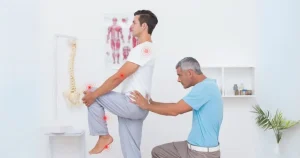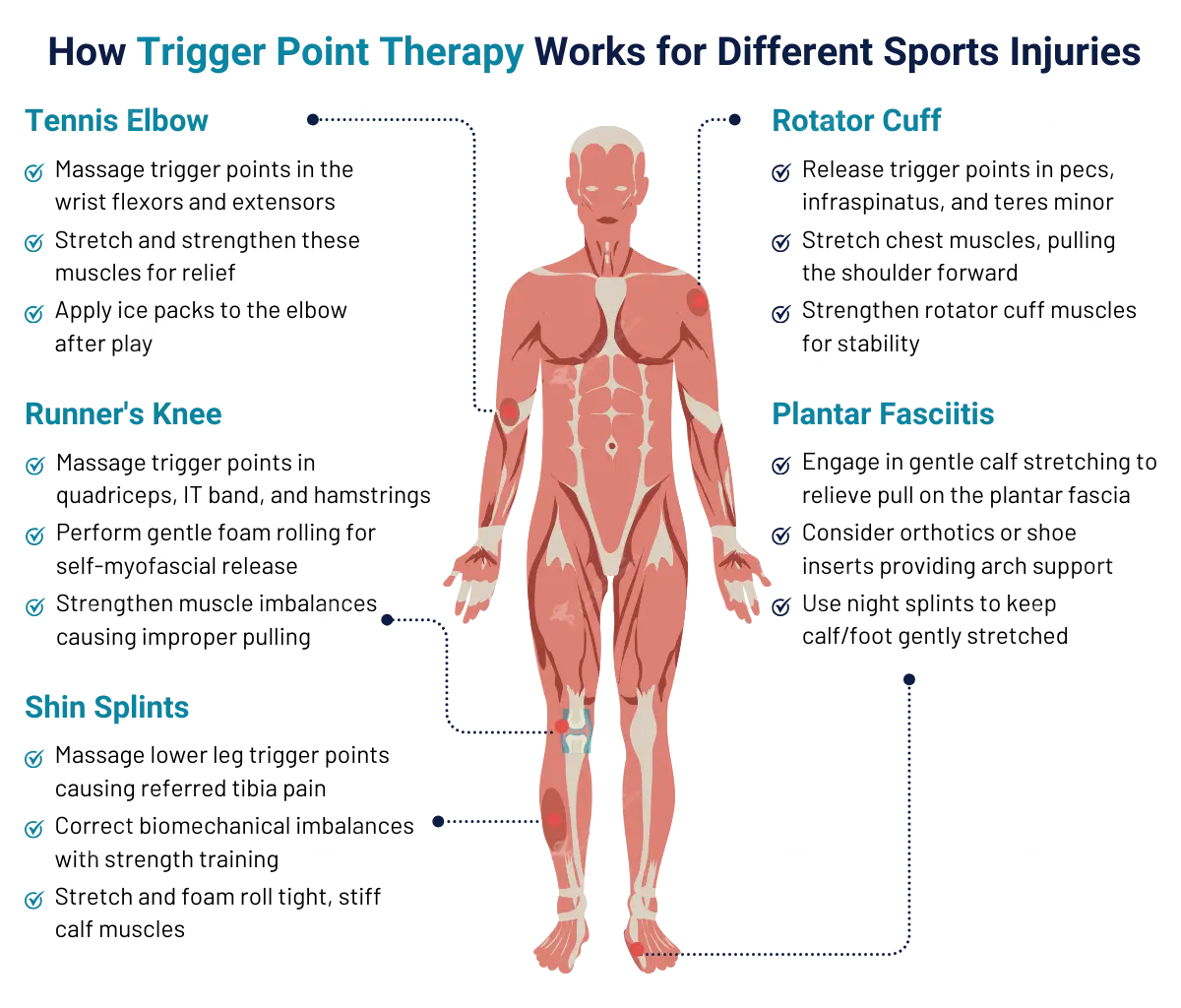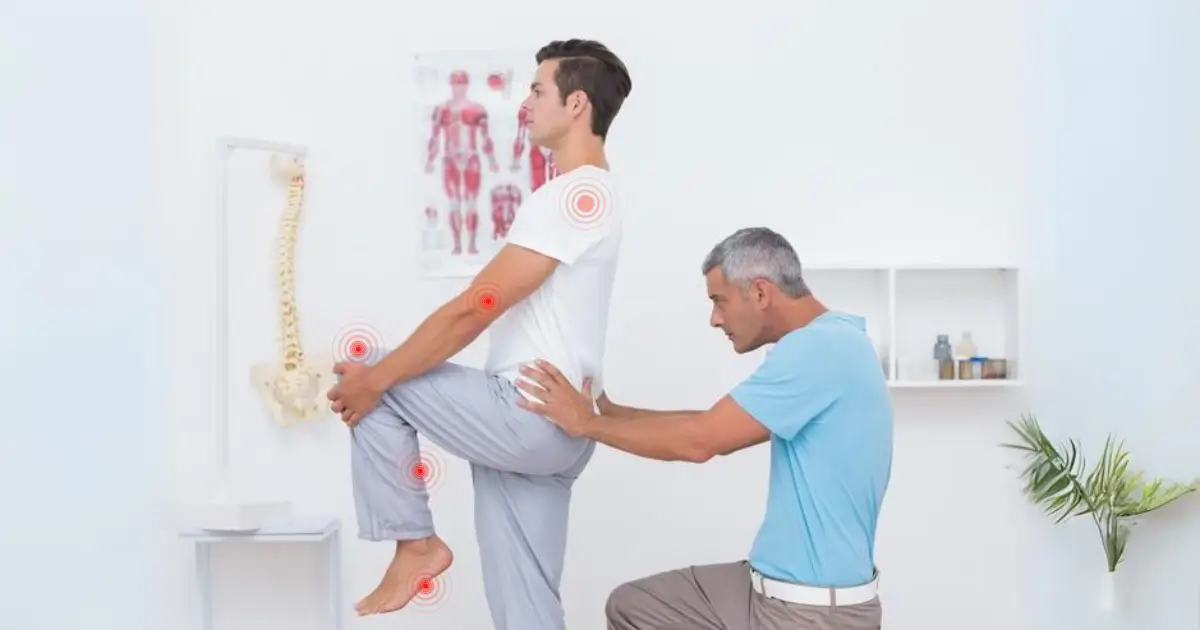
Have you ever wondered why some parts of your body hurt when you press on them, even though the pain seems to come from somewhere else? This is due to trigger points and trigger point therapy can help.
As a registered trigger point therapist with over a decade of expertise, I frequently use this technique to treat sports injuries.
This approach not only aids in pain relief and increases mobility but also plays a crucial role in enhancing athletic performance. The massage helps release tension in people suffering from muscle pain by focusing on these trigger points.
In this blog post, I’ll explain what trigger point massage is, why it helps sports injuries, and how to use it for common injuries like tennis elbow, runner’s knee, and rotator cuff issues.
Understanding Trigger Points
- Overuse and strain injuries
- Poor posture and muscle imbalances
- Accidents and trauma to the tissues
- Nutritional deficiencies
- Chronic stress
Common Symptoms of Trigger Points
- Localized soreness when touched
- Muscle tightness and decreased flexibility
- Muscle twitching and spasms
- Sharp, stabbing pain
- Numbness and tingling
- Referral pain in surrounding areas
Trigger Point Massage Therapy and Its Techniques
Trigger point therapy is a massage that applies targeted pressure to manually break up painful trigger points, says the American Massage Therapy Association. It releases muscle tension, improves circulation, relieves pain, and restores mobility to the injured area.
As a trigger point massage therapist, I use several protocols to deactivate the painful muscle knots in my clients:
1. Manual Release
I use my fingers, knuckles, and elbows to apply direct, sustained pressure to the trigger points. I hold this for 30 seconds up to a few minutes, pressing deeply into the tight muscle fibers.
This compression encourages fresh blood flow to the area and helps the muscle tissues relax. It may cause some initial discomfort, but my clients feel much better afterwards!
2. Massage Tools
I also use massage balls, rollers, and canes to allow clients to apply pressure to hard-to-reach spots between appointments. I teach them to slowly roll over the tense knots for 30-60 seconds to get a self-release of built-up tension.
3. Stretching
I give my clients gentle, therapeutic stretches to help loosen stiff, shortened muscles with trigger points. However, I caution them to avoid aggressive stretching, which could overstrain healing muscle tears.
4. Heat Therapy
I recommend that clients apply heat, such as heating pads, hot packs, or warm baths, before and after massage sessions. It boosts blood circulation to feed tense muscles. Heat therapy helps release knots when paired with massage.
5. Lifestyle Factors
I educate my clients on getting proper nutrients, staying hydrated, reducing stress, and resting injured tissues. These healthy habits help prevent and deactivate trigger points so clients feel better longer.
If massage pressure feels uncomfortable, I recommend my client communicate openly. I also advise them to drink plenty of water afterwards to flush out inflammation. My goal is for clients to keep making progress pain-free!
Related, Is trigger point therapy effective?
Let’s now discuss how trigger point massage for sports injuries works.
Trigger Point Massage for Tennis Elbow
- Pain/tenderness on the elbow’s outer edge
- Stabbing pain down the forearm
- Weakened wrist and grip strength
- Elbow stiffness/reduced range of motion
Treatment
- Massage trigger points in the wrist flexors and extensors
- Stretch and strengthen these muscles for relief
- Tennis elbow straps provide support during activity
- Apply ice packs to the elbow after play
Trigger Point Therapy for Runner's Knee
- Dull, aching knee pain when walking upstairs
- Knee stiffness/swelling after activity
- Muscle weakness around the knees
- Crepitus/crunching sounds in the knee
Treatment
- Massage trigger points in quadriceps, IT band, hamstrings
- Gentle foam rolling for self-myofascial release
- Strengthen muscle imbalances causing improper pulling
- Wear shock-absorbing shoes for cushioning
Trigger Point Therapy for Plantar Fasciitis
- Trigger point massage focused on calf muscles and plantar fascia
- Gentle calf stretching to relieve plantar fascia pull
- Orthotics or shoe inserts providing arch support
- Night splints keep calf/foot stretched
Treatment
- Anticoagulant medication usage puts patients at a higher bleeding/bruising risk
- Advanced osteoporosis
- Cancer and metastases
- Congestive heart failure
- Kidney disease or organ transplant history
- Certain infections and site-specific inflammatory conditions
- Pregnancy in first & third trimesters due to hormone-related ligament laxity
Trigger Point Massage for Rotator Cuff
- Shoulder stiffness and reduced range of motion
- Shoulder clicking/grinding (crepitus)
- Difficulty lifting arm overhead or behind the back
- Radiating pain down the arm
Treatment
- Release trigger points in pecs, infraspinatus, teres minor
- Stretch chest muscles, pulling shoulder forward
- Strengthen rotator cuff muscles for stability
- Adjust activity technique, putting less strain on the shoulder
Trigger Point Massage for Shin Splints

- Sharp shin pain when walking/running
- Inner shin tenderness and possible swelling
- Foot overpronation
- Muscle tightness in calves and feet
Treatment
- Massage lower leg trigger points causing referred tibia pain
- Correct biomechanical imbalances with strength training
- Stretch and foam roll tight, stiff calf muscles
- Wear shock-absorbing shoes with arch support
Are You Suffering from a Lingering Sports Injury?
Get back to peak performance with our targeted trigger point therapy.
Get AppointmentStart Healing with Trigger Point Massage
Trigger point therapy is highly effective for healing chronic sports injuries. The targeted massage techniques deactivate painful muscle knots that cause swelling, stiffness, cramping, and mobility problems after an injury.
Athletes experience less pain, increased flexibility and strength, fewer spasms, and a faster return to sports by releasing these trigger points.
I encourage anyone struggling with a nagging sports injury to explore trigger point massage at our clinic. I can create a customized treatment plan to make you feel better quickly. Invest in your health, and don’t wait to start living pain-free again.

Meet Dr. Craig Eymann, a dedicated chiropractor and yoga enthusiast with over two decades of expertise in spinal health, sports chiropractic, and personalized care, prioritizing misalignment correction for swift injury resolution.
Categories
Tags
Recent Blogs




Leave A Comment